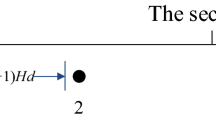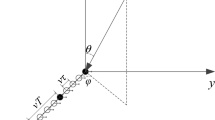Abstract
This paper links the acoustic vector-sensor array parameter estimation problem to the trilinear model. We derive a blind two dimensional direction of arrival (DOA) estimation algorithm for arbitrarily spaced acoustic vector-sensor array at unknown location when exploiting the approach of trilinear decomposition. We present a novel method which illustrates better DOA estimation performance compared to ESPRIT algorithm. Furthermore, our algorithm requires no spectral peak searching or pair matching. Numerical results demonstrate the validity of our algorithm.
Similar content being viewed by others
References
Sun G., Li Q., Zhang B. (2006) Acoustic vector sensor signal processing. Chinese Journal of Acoustics 25(1): 1–15
Nehorai A., Paldi E. (1994) Acoustic vector-sensor array processing. IEEE Transactions on Signal Processing 42(9): 2481–2491
Sun G., Yang D., Zhang L. (2003) Maximum likelihood ratio detection and maximum likelihood DOA estimation based on the vector hydrophone. Acta Acustica 28(1): 66–72
Hawkes M., Nehorai A. (1998) Acoustic vector-sensor beamforming and Capon direction estimation. IEEE Transactions on Signal Processing 46(9): 2291–2304
Chen H., Zhao J. (2004) Wideband MVDR beamforming for acoustic vector sensor linear array. IEE Proceedings-Radar, Sonar & Navigation 151(3): 158–162
Hochwald B., Nehorai A. (1996) Identifiability in array processing models with vector-sensor applications. IEEE Transactions on Signal Processing 44(1): 83–95
Wong K. T., Zoltowski M. D. (1997) Closed-form underwater acoustic direction-finding with arbitrarily spaced vector hydrophones at unknown locations. IEEE Journal of Oceanic Engineering 22(3): 566–575
Wong K. T., Zoltowski M. D. (1997) Extended-aperture underwater acoustic multisource azimuth/elevation direction-finding using uniformly but sparsely spaced vector hydrophones. IEEE Journal of Oceanic Engineering 22(4): 659–672
He J., Jiang S., Wang J., Liu Z. (2009) Direction finding in spatially correlated noise fields with arbitrarily-spaced and far-separated subarrays at unknown locations. IET Radar, Sonar & Navigation 3(3): 278–284
Wong K. T., Zoltowski M. D. (1999) Root-MUSIC-based azimuth-elevation angle-of-arrival estimation with uniformly spaced but arbitrarily oriented velocity hydrophones. IEEE Transactions on Signal Processing 47(12): 3250–3260
Wong K. T., Zoltowski M. D. (2000) Self-initiating MUSIC-based direction finding in underwater acoustic particle velocity-field beamspace. IEEE Journal of Oceanic Engineering 25(2): 262–273
Wang, Y., Zhang, J., Hu, B., & He, J. (2008). Hypercomplex model of acoustic vector sensor array with its application for the high resolution two dimensional direction of arrival estimation. In Proceedings of the IEEE instrumentation & measurement technology conference (IMTC’ 2008) (pp. 1–5). Victoria, BC.
Yuan, Y., Zhang, B., Fan, D., & Tong, G. (2008). DFT and PSD for estimating DOA with an active acoustic array. In IEEE international conference on automation & logistics (ICAL’ 2008) (pp. 694–699).
Arunkumar, K. P., & Anand, G. V. (2007). Multiple source localization in shallow ocean using a uniform linear horizontal array of acoustic vector sensors. In 2007 IEEE intelligent information communication technologies for better human life (TENCON 2007) (pp. 1–4). Taibei, China.
Tam P. K., Wong K. T. (2009) Cramer-Rao Bounds for direction finding by an acoustic vector sensor under nonideal gain-phase responses. IEEE Sensors Journal 9(8): 969–982
Abdi A., Guo H. (2009) Signal correlation modeling in acoustic vector sensor arrays. IEEE Transactions on Signal Processing 57(3): 892–903
Hawkes M., Nehorai A. (2003) Wideband source localization using a distributed acoustic vector-sensor array. IEEE Transactions on Signal Processing 51(6): 1479–1491
Nan, Z., Swee, C. C., & Chew, B. A. L. (2007) Vector hydrophone array development and its associated DOA estimation algorithms. In Proceedings of 2006 Asia Pacific OCEANS (pp. 1–5). Singapore.
Kruskal J. B. (1977) Three-way arrays: Rank and uniqueness of trilinear decompositions, with application to arithmetic complexity and statistics. Linear Algebra and its Applications 18: 95–138
De Lathauwer L., De Moor B., Vandewalle M. J. (2004) Computation of the canonical decomposition by means of a simultaneous generalized schur decomposition. SIAM Journal on Matrix Analysis and Applications 26(2): 295–327
De Lathauwer L. (2006) A link between the canonical decomposition in multi-linear algebra and simultaneous matrix diagonalization. SIAM Journal on Matrix Analysis and Applications 28(3): 642–666
Sidiropoulos N. D., Giannakis G. B., Bro R. (2000) Blind PARAFAC receivers for DS-CDMA systems. IEEE Transactions on Signal Processing 48(3): 810–823
Sidiropoulos N. D., Dimic G. Z. (2001) Blind multiuser detection in W-CDMA systems with large delay spread. IEEE Signal Processing Letters 8(3): 87–89
Sidiropoulos N. D., Bro R., Giannakis G. B. (2000) Parallel factor analysis in sensor array processing. IEEE Transactions on Signal Processing 48(8): 2377–2388
Rong Y., Vorobyov S. A., Gershman A. B., Sidiropoulos N. D. (2005) Blind spatial signature estimation via time-varying user power loading and parallel factor analysis. IEEE Transactions on Signal Processing 53(5): 1697–1710
Sidiropoulos N. D., Liu X. (2001) Identifiability results for blind beamforming in incoherent multipath with small delay spread. IEEE Transactions on Signal Processing 49(1): 228–236
Zhang, X., & Xu, D. (2007). Blind PARAFAC signal detection for polarization sensitive array. EURASIP Journal on Advances in Signal Processing, 2007(article id 12025), 1–7. doi:10.1155/2007/12025.
Zhang X., Shi Y., Xu D. (2008) Novel blind joint direction of arrival and polarization estimation for polarization-sensitive uniform circular array. Progress in Electromagnetics Research: PIER 86: 19–37
De Baynast, A., De Lathauwer, L., & Aazhang, B. (2003). Blind PARAFAC receivers for multiple access-multiple antenna systems. In IEEE 58th vehicular technology conference (pp. 1128–1132).
Yu, Y., & Petropulu, A. P. (2006). PARAFAC based blind estimation of MIMO systems with possibly more inputs than outputs. IEEE international conference on acoustics, speech and signal processing (ICASSP’ 06) (pp. 133–136).
Liu X., Sidiropoulos N. D., Swami A. (2002) Blind high-resolution localization and tracking of multiple frequency hopped signals. IEEE Transactions on Signal Processing 50(4): 889–901
Zhang X., Xu D. (2009) Novel joint time delay and frequency estimation method. IET Radar, Sonar & Navigation 3(2): 186–194
Vorobyov S. A., Rong Y., Sidiropoulos N. D. (2005) Robust iterative fitting of multilinear models. IEEE Transactions on Signal Processing 53(8): 2678–2689
Bro, R., Sidiropoulos, N. D., & Giannakis, G. B. (1999). A fast least squares algorithm for separating trilinear mixtures. In Proceedings of the International Workshop ICA and BSS (pp. 289–294). France.
Stoica P., Nehorai A. (1990) Performance study of conditional and unconditional direction-of-arrival estimation. IEEE Transactions on Signal Processing 38: 1783–1795
Author information
Authors and Affiliations
Corresponding author
Rights and permissions
About this article
Cite this article
Zhang, X., Li, J., Chen, H. et al. Trilinear Decomposition-Based Two-Dimensional DOA Estimation Algorithm for Arbitrarily Spaced Acoustic Vector-Sensor Array Subjected to Unknown Locations. Wireless Pers Commun 67, 859–877 (2012). https://doi.org/10.1007/s11277-011-0415-3
Published:
Issue Date:
DOI: https://doi.org/10.1007/s11277-011-0415-3




